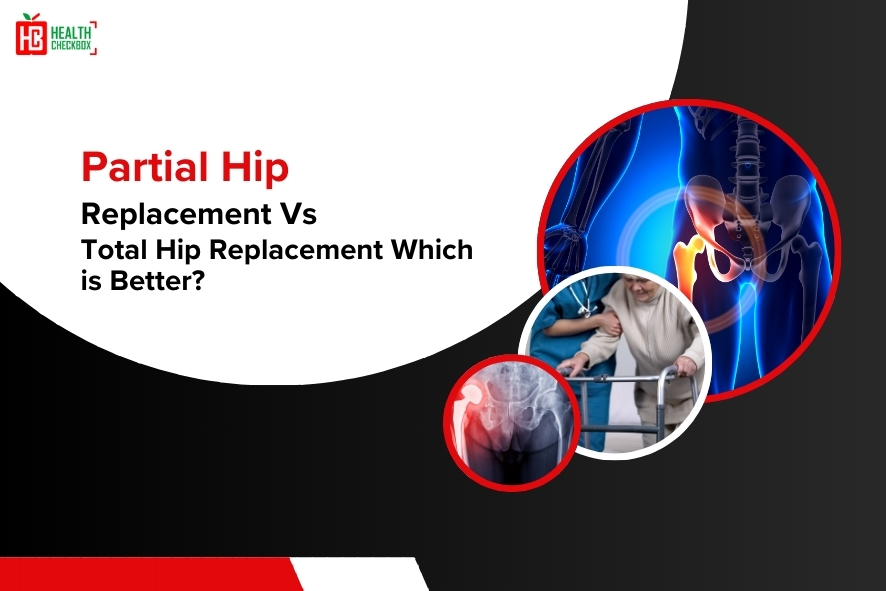When an individual faces unbearable hip pain, and every other possible treatment fails to work. Hip replacement surgery is the only option left. Therefore, people often confuse and wonder about the difference between hip replacement and total hip replacement, or whether a partial hip replacement vs total hip replacement would be a better option. We will discuss the difference between them and their functionality, their approaches, and their benefits.
Hip replacement is a broader term, including partial hip replacement and total hip replacement; both are different types of hip replacements. There are different benefits of both of them, different medical conditions, and different requirements of surgery.
Understanding Hip Replacement Surgery
When an artificial part replaces a damaged or diseased part of the hip joint is known as hip replacement surgery. The joint connects the two bones, the acetabulum and the femur. When the joint is damaged due to any injury or conditions like arthritis, this surgery can provide relief, reduce pain, and improve mobility. Eventually, it will enhance the quality of life.
Types of Hip Replacement
There are multiple types of hip replacements are there:
- Femoral Head Resurfacing: The surface of damaged or diseased bone is replaced by metal and resurfaced.
- Bipolar Hemiarthroplasty: A large metal ball with a larger head is used in this to provide two articulation points.
- Monopolar Hemiarthroplasty: A metal ball replaces only the femoral head, which is connected directly to the acetabulum.
Partial Hip Replacement vs Total Hip Replacement: Key Differences
The main difference between partial hip replacement and total hip replacement is in the surgical part, where the joints are being replaced:
| Partial Hip Replacement | Total Hip Replacement |
| 1. Replacing only the ball portion of the head of the femur. 2. This surgery is performed when only the femoral head is damaged. 3. Commonly, in elderly patients. 4. Also known as hemiarthroplasty. | 1. Replacing the ball as well as the socket. 2. This surgery is done when the femoral head, as well as the prosthetic ball, is damaged. 3. Commonly, in sports injuries. 4. It is also known as a complete hip replacement. |
Different Types of Partial Hip Replacement and Total Hip Replacement
There are different types of surgeries in both of them as below:
Total Hip Replacement
Anterior Approach
- The incision made in front of the hip is mostly vertical, but it can be horizontal.
- It allows the surgeon to reach the spot of joint.
- This approach has one of the lowest precautions to measure; however, there are some precautions to avoid the dislocation of the implant.
- In the early weeks of recovery, avoid rotating to put pressure on your hip.
Posterior Approach
- A curved incision is made on the back of the hip
- It should be cut by the surgeon, which helps to have a clear view of the hip to operate further.
- It requires a little extra precaution to avoid the chance of dislocation of the new joint.
- Avoid turning on your toes, crossing your legs while sitting, and moving your hips more than 90 degrees.
Lateral Approach
- The lateral approach is almost similar to the posterior approach.
- It sis also done to have a large and clear view of the hip joint.
- Precautions for this are the same as the anterior approach, as well as the posterior approaches.
Partial Hip Replacement
Unipolar Replacement
- Unipolar replacement is very uncommon because the majority of partial hip replacements are bipolar.
- It is a ball-in-ball design, where a smaller metallic ball rotates inside the larger metallic ball.
- The inner metallic ball is covered by a high-grade polyethylene plastic cover.
Bipolar Replacement
- It has more stability than a unipolar system.
- In this, the mobility is smoother than unipolar, and it also protects the articular cartilage.
- Its joint is completely fixed in this, whereas it is only attached to the head of the bone in a unipolar.
Indications of Partial Hip Arthroplasty vs Total Hip Arthroplasty
The choice between partial and total hip replacement depends on various factors, as given below:
Partial Hip Replacement Indications
- Fractured femoral head, mostly in an elderly person.
- Femoral head necrosis.
- Low activity levels, or patients with limited life expectancy.
- Medical conditions that increase the risk of surgery.
Total Hip Replacement Indications
- A patient with extreme osteoarthritis.
- Patients with rheumatoid arthritis.
- Patients with a dislocated hip.
- Due to injury, mostly younger patients with high-impact activities.
- A person with bilateral hip disease.
Total vs Partial Hip Replacement Surgery Cost In India
The surgical cost for hip replacement in India varies based on multiple factors:
Partial Hip Replacement
The partial hip replacement estimated cost is ₹1,55,000 to ₹4,20,000, it may include all of the following costs:
- Surgery Fees: These fees cover the expertise of the surgeon.
- Implants Cost: The cost totally depends on the type of implant.
- Hospital Charges: Staying cost, cost of ICU, and cost of operating room.
- Pre-operative Costs: Consultations and medical tests before surgery
- Post-operative Care: Recovery process and services related to it, especially physiotherapy.
Total Hip Replacement
The cost of total hip replacement arrond ₹2,56,000 to ₹6,30,000, it may include the following costs:
- Implant: Cost depends on the type of implant; high quality implant lasts for a longer duration but is costly.
- Surgeon’s Fees: Fees for the surgeon’s expertise.
- Facility Charges: Cost of staying in the festival and using the basic facilities.
- Operating Room Charges: the cost of the operating theatre.
- Anesthesia Charges: Anesthesia is given before surgery.
- Pre- and Post-operative care: Consultancy, medical tests, and physiotherapies.
- Medications: Medicines after surgery and other items related to surgery.
Foods to Avoid in Both Types of Hip Replacement
Diet plays a major role after surgery in the recovery process. A patient must know what foods to avoid after a hip replacement. Here are some major ones:
- Inflammation due to high sodium intake.
- Healing can be affected due to excess sugar.
- Packaged foods often contain trans fats, which are harmful during recovery.
- Bone reconstruction can be affected by excess alcohol.
- Purine-rich foods.
A patient must be focused on the food rich in protein and calcium to repair tissues and bones.
Role of Modern Technology in Hip Replacement Surgery
Whether it’s partial hip replacement or total hip replacement, the role of technology in modern hip replacement is a lot. These new achievements in the medical field revolutionized the traditional surgical treatments by the addition of some useful tools and techniques, such as:
- For precise implant positioning, computer-assisted navigation is best.
- Robotic surgery equipment for highly enhanced accuracy.
- Detailed imaging for better surgical planning.
- Use of 3D printing for custom prostheses.
- Minimally invasive processes reduce tissue trauma.
Conclusion
Between partial hip replacement vs total hip replacement, both offer high-quality solutions for hip-related problems. But the fact is, the type of treatment totally depends on the patient’s condition and requirements. While partial is a good option for specific conditions like femoral fractures.
On the other hand, total hip replacement offers wider mobility and joint diseases. Deciding between surgical and non-surgical approaches, the objective remains the same. To restore the functionality, minimise pain, and enhance the quality of life.

